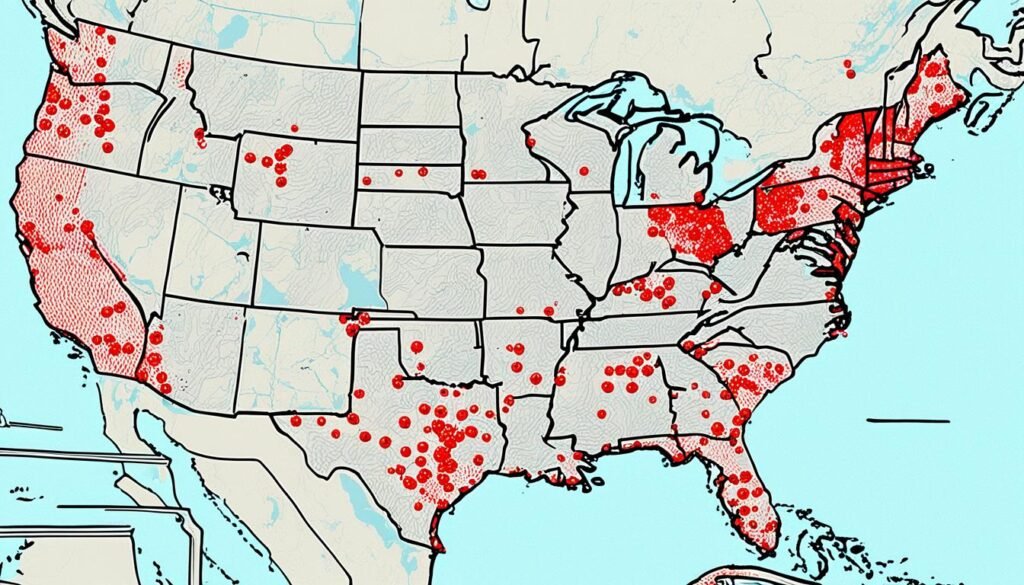Real estate investment opportunities flourish in the United States, where savvy investors seek out the best states to invest in real estate for high returns and sustainable growth. In-depth analyses of property investment rankings reveal that certain regions offer more advantageous conditions, driven by demographic shifts and market trends1. For instance, the analysis suggests about 320,000 homes valued up to $256,000 are necessary to satisfy the current buyer demand1. Cities such as Houston and Atlanta, along with Denver and municipalities within Austin, Texas, have witnessed an uptick in properties purchased by investors, signifying a robust market and state with the highest ROI potential1.
The South, especially, has seen a notable 6.5% growth in investor purchases, whereas the West enjoyed a significant 16% spike during the same period1. Specific areas like the Austin metropolitan zone and Georgetown, Texas, have seen more than 63,000 new residents between 2021 and 2022, with growth rates of 2.7% and an exceptional 14.4%, respectively1. Atlanta itself has welcomed more than 66,000 newcomers from April 2022 to April 20231. These statistics not only highlight emerging real estate investment opportunities but also shed light on shifting residential preferences.
Key Takeaways
- Identify emerging real estate markets with robust growth for better investment returns.
- Pay attention to demographic trends indicating increased demand for properties.
- Select regions for property investments with favorable tax rates and growth potential.
- Factor in both property values and population growth when calculating potential ROI.
- Consider diversifying investments across regions benefiting from an influx of new residents.
1. South Carolina’s Real Estate Market: A Hidden Gem
Amidst the lucrative real estate states in the US, South Carolina’s real estate emerges as a particularly profitable real estate location, offering significant investment potential. With enchanting cities like Charleston and Columbia, known for their hospitality and low crime rates, the state cultivates an environment ripe for investment. Notably, Spartanburg, South Carolina, heralds as a standout market, characterized by an ideal median home value of $181,571 and celebrated for the second-highest cumulative population growth rate2.
Wielding a potent combination of affordable living and robust economic indicators, South Carolina real estate is poised for growth. The state’s low property taxes, only 0.57%, make it an attractive prospect3. This, coupled with a below-average median home price of $170,000, despite an upward trend of a 1% value increase, invites savvy investors to capitalize on the potential for returns3.
Driving the allure for this charming state is more than just the economic prospects; it’s also about the people who call it home. Approximately 30% of residents choose to rent, at an attractive cost averaging $922 per month, illustrating the state’s profitable real estate environment3. With a population growth rate of 1.27% and an employment growth of 1.43%, South Carolina isn’t just growing; it’s thriving and presenting an optimal moment for investment3.
Experts are recognising these trends, with a group of 20 economic and housing authorities surveyed by the NAR predicting a median home price increase of approximately 5.7% next year3. Such insights underline South Carolina’s investment potential, making it a must-watch in the real estate market for those looking towards the future. Property investors are encouraged to observe these metrics closely, as the hidden gem markets, which include cities in South Carolina, have more room for growth in 2022, according to NAR chief economist Lawrence Yun3.
| Statistical Factor | Value | Market Indicator |
|---|---|---|
| Property Taxes | 0.57% | Affordability |
| Median Home Price | $170,000 | Market Entry |
| Rental Population | 30% | Demand for Housing |
| Monthly Rent Average | $922 | Rental Income Potential |
| Population Growth Rate | 1.27% | Demographic Expansion |
| Employment Growth Rate | 1.43% | Economic Vitality |
| Projected Home Price Increase | 5.7% | Investment Appreciation |
South Carolina’s unique blend of historical allure, economic viability, and population dynamism establishes it as a beacon among the most lucrative real estate opportunities. For investors eyeing profitable real estate locations with long-term growth potential, South Carolina beckons as a promising canvas ready for investment brushstrokes.
2. Idaho’s Growing Appeal to Real Estate Investors
As U.S. states jostle for the attention of savvy property investors, Idaho emerges as a focal point for dynamic growth in the real estate sector. With its robust economic indicators and burgeoning rental market, this northwestern haven beckons as one of the top real estate markets to consider.
Boise’s Real Estate Boom: What You Need to Know
In the heart of Idaho, Boise stands as a testament to the state’s real estate prosperity. An 8% annual increase in median incomes has translated into a vibrant Boise property investment scene, with property values appreciating significantly from $230,000 to over $250,0004. This growth is underpinned by Idaho’s leading position in year-over-year nonfarm job growth for March4 and the impressive upward trajectory of its labor force4. The city’s low crime rates and picturesque surroundings only add to its allure, making it a magnet for both residents and investors alike.
Idaho’s Rising Rental Market: Potential for Investors
Renters comprise 28.4% of Idaho’s populace, often drawn by the affordable $900 average housing cost4. The rental market analysis reveals a state in the throes of a 2% annual population growth, further emphasizing the market’s strength4. When blending these figures with the state’s holistic approach to development—including unprecedented fiscal measures like cuts to unemployment insurance taxes for businesses by 20%4 and significant ongoing investment into infrastructure4—Idaho real estate offers a rich tapestry of opportunity.
The state government’s robust backing of education initiatives such as the Accelerating Public Charter Schools Act and LAUNCH, a grant program for high school seniors4, points toward a future-proof strategy. It seeks not just to entice immediate investment but to sustain long-term growth and stability within Idaho’s top real estate markets.
| Indicator | Data | Impact on Real Estate Market |
|---|---|---|
| Annual Median Income Growth | 8% | Increases purchasing power and property demand |
| Average Property Value Increase | $20,000+ | Signifies asset appreciation and investment profitability |
| Population Growth | 2% | Drives rental market demand and development potential |
| Rental Market Share | 28.4% | Indicates a solid tenant base for rental properties |

Idaho’s economic vision, juxtaposed with the encumbering housing crisis observed in states like Texas5, reveals a stark contrast that could shape real estate trends. While areas in Texas grapple with housing shortages and affordability issues5, Idaho is seen to be crafting a propitious climate for investment, enhanced by supportive state legislation. There is a clear shift toward states that not only present economic resilience but offer inhabitants and investors a well-rounded quality of life.
The influx of investment into Idaho’s real estate is not accidental; it’s the result of calculated advancements in policy and infrastructure that signal long-term growth. For those poised to capitalize on top real estate markets, Idaho is a state that can no longer be overlooked in the rental market analysis. Its trajectory suggests a blossoming hub for both residential satisfaction and investor returns.
3. North Carolina: A Blend of Natural Beauty and Investment Opportunity
The backdrop of North Carolina’s rolling mountains juxtaposed with its pristine coastline is not just a feast for the eyes but also a promising canvas for real estate investment trends. Cities like Charlotte and Raleigh are burgeoning with Charlotte investment opportunities and Raleigh market potential, thanks to their robust job markets and esteemed educational institutions.

The recent shift in North Carolina real estate underscores a market where foresight and speed are of the essence. With a year-over-year decrease in listings by 5.1% and sales by 5.9%6, the scarcity in availability is creating a hotbed of competition among buyers. Notwithstanding this tight market, the median sales prices have surged by a substantial 10.5%6, allowing homeowners to witness an appreciation in their investments.
The Desirability of Charlotte and Raleigh for Tenants and Investors
In the heartland of the state, the allure of Charlotte and Raleigh continues unabated. These hubs of commerce and culture have not only captured the attention of tenants seeking quality living but also of investors keen on tapping into the North Carolina real estate potential. The average home value stands robust at $322,527, with a commendable year-over-year bump of 4.1%6. The swift pace of the market is further exemplified by homes spending a mere 21 days on average before turning to pending status6.
| City | Median Sales Price | Avg. Days on Market | Over List Price Sales (%) |
|---|---|---|---|
| Charlotte | $322,527 | 21 | 24.46 |
| Raleigh | $322,527 | 21 | 58.06 |
The influx of nearly 140,000 people between 2022 and 20237 signals a demographic shift, contributing to the fabric of a dynamic community that enhances both the rental and sales markets. Areas like Cary boast impressive median incomes of $125,317 and lower rent-to-income ratios of 17%, laying the groundwork for a less rent-burdened population7. Concord, with its burgeoning population and low crime rate, joins the ranks of these desirable locales drawing investors’ eyes7.
With Zillow’s projections positing home price increases in cities ranging from 3.3% to 4.9%6, and Chapel Hill spotlighting high life expectancy and ample healthcare providers per capita7, North Carolina indeed presents a harmonious blend of natural allure and tangible investment viability. The real estate tapestry here is resilient, driven by favorable interest rates and an uptick in home values, framing North Carolina as a beacon for discerning buyers and investors alike.
4. Florida: Sunshine State’s Bright Investment Prospects
The allure of the Sunshine State extends beyond its golden beaches and palm-laden landscapes, as Florida real estate investment endures as a robust sector. A cascade of factors, from scenic allure to economic vigor, craft an environment ripe for investment.
Florida’s No Income Tax Advantage for Real Estate Investors
Florida’s pledge to shun a state income tax bolsters its attractiveness, presenting significant tax advantages for both inhabitants and investors. This fiscal perk amplifies the gains on real estate ventures, making Florida a magnet for both national and global investors.
Analyzing Florida’s Property Tax Impact on Investment Returns
Nevertheless, property tax considerations remain a pivot point for investors – while higher than some states, Florida’s property tax policies are balanced by generous homestead exemptions, safeguarding homeowner value.
Real estate market analysis in locales such as New Smyrna Beach uncovers a vibrant scenario: a 10.8% elevation in median home prices and an average listing price of $710,569, painting a picture of a thriving market8. With homes lingering on the market for an average stint of 141 days and the median home price reaching $480,600, property investment in Florida is poised for those seeking value in prime locations8.
Low interest rates and an uptrend in remote work are fueling a rising tide of homeownership and investment possibilities in New Smyrna Beach. This is manifesting in a rich tapestry of real estate opportunities—from cozy residences to opulent oceanfront estates—suiting a broad swath of investor preferences8.
| Statistic | Data Point | Impact on Real Estate Investment |
|---|---|---|
| Median Home Price Increase | 10.8% | Indicates growth potential |
| Average Home List Price | $710,569 | Reflects a strong market value |
| Average Market Duration | 141 days | Shows a balanced supply-demand |
| Median Home Price in New Smyrna Beach | $480,600 | Marks a prime investment location |
The vision of future growth in New Smyrna Beach’s real estate market shines brightly, propelled by an enthralling coastal lifestyle, modern conveniences, and the heart-warming welcome of its community8. Investors find solace in the steady uptick of property values, the thriving societal milieu, minimal crime rates, and commendable educational institutions – all paving the route for sustainable investor interest in Florida8.
5. Tennessee: The Volunteer State, High Returns Meet Southern Charm
The allure of Tennessee real estate is undeniable, with the state’s harmonious blend of scenic landscapes and vibrant cultural life leading the charge. Major urban centers, like Nashville, not only present iconic musical backdrops but also offer profitable real estate locations for investors seeking growth and sustainability.
At the heart of Tennessee’s appeal are the tax benefits that draw property owners from across the nation. The state boasts an attractive property tax rate of just 0.71%, significantly lower than many of its national counterparts. Moreover, potential investors are often enticed by the absence of state income tax, providing a much-appreciated financial reprieve and contributing to an overall healthy investment climate.
How Tennessee’s Tax Regulations Benefit Property Owners
Tennessee’s tax regulations are a boon for property owners, ensuring their investments are safeguarded and profits maximized. Coupled with an average property value increase of 8%, Tennessee stands out as a hotspot for those looking to dive into the real estate market9.
Nashville’s Music Scene and Real Estate Synergy
The real estate and entertainment synergy in Nashville creates a unique environment where live music venues and cultural festivities act as a significant draw for tourists and new residents alike. This cultural richness does more than elevate the city’s prestige; it invigorates the rental market, catering to the one-third of Tennesseans who opt to rent their homes at an average cost of approx. $910 per month9.
The rapid growth in job opportunities, with a rate increase of 4.14%, underscores the region’s economic stability and makes a compelling case for investment in Tennessee—a state where high returns and Southern charm coalesce into a single package of irresistible opportunities9.

| Tennessee vs. Neighboring States: Millionaire Households | Tennessee | Mississippi | Arkansas |
|---|---|---|---|
| Total Households | 8,386,508 | 1,131,470 | 1,189,790 |
| Millionaire Households | 6.71% | 4.18% | 4.33% |
| Year-over-Year Increase | 0.50% (2018-2019) | Not Applicable | Not Applicable |
The above table showcases Tennessee’s remarkable standing in the Southeast, possessing a higher ratio of millionaire households than its neighboring states9. This affluence not only facilitates higher investment levels in Tennessee real estate but also indicates a flourishing economy ripe for new development and prosperity.
6. Colorado’s High Altitude Elevates Real Estate Opportunities
Colorado’s appeal as one of the most lucrative real estate states is not just a matter of its high mountains and stunning scenery, but also its vibrant market dynamics and investment-friendly tax environment. With a low property tax of 0.51% and a manageable flat income tax rate of 4.55%, investors find Colorado property ventures both accessible and promising. The state’s median income of $77,000 overshadows the national mean, signifying the presence of high-income real estate opportunities that attract discerning investors and affluent tenants alike.

Recent statistical data underpins Colorado’s strong market position, with the Denver-Aurora-Lakewood MSA leading at 74.8, marking a commendable 7-point ascent from last year10. Despite a slight decline in median sales prices from $595,000 to $550,000, the Denver real estate landscape has shown resilience with an impressive 25% spike in inventory and a notable increase in the median closed price for homes to $575,000 as of February 202410. Furthermore, the demand in this market segment remains robust, evidenced by 6,862 properties listed for sale and nearly a quarter of sales closing above the asking price10.
The culture of property appeals in Colorado reveals an encouraging trend: over 13,000 appeals were made during the last assessment hike in Adams County, and an impressive 41% of those assessments were subsequently changed11. Importantly, homeowners incur no cost from appealing to the assessor—an advantage for those looking to correct property valuations11. To aid homeowners, the Colorado Division of Property Taxation provides a key resource for verifying property details, which are crucial for accurate assessments and ensuring that valuation discrepancies, such as overlooked property improvements or inaccurate acreage, are amended11.
The state government, helmed by Governor Jared Polis, has demonstrated responsiveness to the needs of residents, as seen by initiatives like fully funding K-12 education and capping EpiPen prices12. Housing affordability, however, remains a concern, with Colorado witnessing significant increases in housing costs, which have not been matched by corresponding income rises; mortgage payments have surged by 73% since early 202212. To combat these barriers, Polis recently signed an Executive Order aimed at improving the efficiency of housing-related administrative processes12.
As for diversifying housing options, Coloradans are overwhelmingly in favor of integrating Accessory Dwelling Units (ADUs) within their communities, with more than 80% support. ADUs not only increase property value but also cater to the needs of renting families, providing a win-win for property owners and tenants alike12.
| Key Metric | Statistical Data | Impact on Real Estate Market |
|---|---|---|
| Median Sales Price | $575,000 (2024) | Reflects steady market growth despite national trends |
| Inventory Levels | 25% increase (2024) | Indicates a robust and evolving market |
| ADU Community Support | 80% approval | Shows Colorado’s progressive stance on housing diversity |
| Appeal Success Rate | 41% of assessments changed | Highlights homeowner engagement and rectification opportunities |
Colorado’s real estate market continues to underpin the state’s economic vitality and offers a wealth of opportunities for those looking to engage in property investment. By aligning with Colorado’s market trends, state resources, and legislative initiatives, investors can leverage the high-income real estate opportunities that this top-ranking state generously provides.
7. Arizona: Real Estate Prosperity Under The Sun
The expansive and radiant Arizona landscape offers more than just breathtaking sunsets and desert beauty; it stands as a bastion of burgeoning opportunity in the realm of real estate. This is further enhanced by the enterprising Phoenix investment opportunities that beckon both savvy investors and aspiring homeowners. With a particular focus on Phoenix and its surrounding regions, we delve into the dynamics of Arizona’s real estate and rental markets, observing the robust tenant demand in rental markets that contribute significantly to the state’s flourishing economic profile.
Phoenix Market Dynamics: Why Arizona is Lucrative
In the heart of the Valley of the Sun, Phoenix commands attention as a nucleus for Arizona real estate growth and potential. The iconic cityscape, fused with an ever-growing job sector, has led to a nearly 5% increase in median household income, inviting more residents to call this metropolis home13. Amidst the urban expansion, the average property value has seen a steady upward trajectory, placing the average home value in the region at around $255,90013. As we gaze upon the real estate horizon, properties in desirable communities such as Arcadia, Phoenix, and Biltmore Estates in Phoenix represent the epitome of luxury living, with average home prices of $3.5 million and $8 million respectively14.

Delving into the high-end market, areas like Ancala in Scottsdale and the coveted Estancia reflect sophistication and affluence, boasting average home prices at $1.6 million and around $4 million respectively14. Unique to Arizona’s real estate palette, custom-designed homes accentuate the perspective of luxury, with Troon North and Desert Highlands offering elegantly crafted residences amidst premier golfing communities14.
Arizona’s Rental Market: Increasing Tenants’ Demand
The vibrancy of Arizona’s rental market is evident, with a considerable 34.7% rental rate reflecting a nearly one-third tenant occupancy13. This is indicative of a significant tenant demand in rental markets across the region, investment opportunities that Phoenix offers have been particularly appealing, as evidenced by PFP Dorsey Investments acquiring 90 out of 96 units in a Tempe condo building, underscoring an assertive move towards capitalizing on this demand13. The Condominium Act, while currently under legal scrutiny, shapes much of the real estate landscape in Arizona, ensuring that the rights and expectations of property owners are highlighted, and justly protected13. It is this intricate weave of law, lifestyle, and fiscal advantage that positions Arizona, and Phoenix more specifically, as a region ripe with investment possibilities, providing strong assurances to both current and potential stakeholders in Arizona’s soil.
With its favorable climate both meteorologically and economically, the Grand Canyon State presents a compelling argument for those looking to invest, and those seeking to find a place to call home. The tenant demand in Arizona’s rental markets, bolstered by Phoenix investment opportunities, makes for a sunlit pathway to real estate prosperity under the vast Arizona skies.
8. California: Real Estate’s Gold Rush
In the vibrant landscape of California real estate, investors and residents alike navigate a complex terrain marked by high-value investment areas and diverse economic opportunities. The state’s renowned status as an epicenter for innovation and lifestyle continues to attract a steady stream of technology enthusiasts, entertainment moguls, and vacation seekers. Yet, even with living costs on the upscale, the investment prospects shine brighter than ever.

Interest rates in Southern California’s real estate market have seen an uptick, reflecting a nationwide trend and affecting affordability for some buyers15. Despite this increase, the allure of California’s lifestyle and economy has not waned, with an impressive inventory movement indicating robust demand. The attraction is clear: over 43,000 single-family homes were sold in L.A. County in 2021, followed by more than 42,000 sales in 2022, underscoring the state’s resiliency in the face of economic shifts15.
California boasts not only picturesque landscapes but also areas rich in economic vitality. From the awe-inspiring peaks framing Julian Estates near San Diego to the lively urban access of neighborhoods within the embrace of Los Angeles, there’s an unmistakable draw for those seeking to invest or nestle in. Accordingly, areas like Julian Estates have witnessed a commendable appreciation in real estate value, testifying to a growing interest in making these idyllic settings one’s permanent haven16.
However, the gains are not equally distributed. Experience in the industry paints a stark picture of income disparities, where seasoned real estate agents average a median gross income of $80,700, in contrast to their less experienced counterparts who earn around $9,60015. Additionally, January’s bitter chill was felt in 31% of real estate firms, which struggled to pay office rent, hinting at the underlying challenges of the marketplace15.
California’s real estate market, subject to the whims of economic cycles, remains a beacon of opportunity amidst challenges. Whether it is navigating through the second-most robocalls in the United States or the recent 4.75% decline in National Association of Realtors (NAR) membership within the state, professional resilience is key15. Nevertheless, the diverse economic opportunities extend well beyond the traditional buying and selling of homes, further solidifying its high-value investment reputation.
In summary, despite complex market forces and demographic shifts, California continues to stand out as a glittering center for high-value investment territories, offering unmatched diverse economic opportunities. The prospects for investors and residents remain potent, crafting a narrative that is as dynamic as the Golden State itself.
9. Indiana: A Crossroad of Real Estate Affordability and Growth
Discovering Indiana real estate is like uncovering a well-kept secret in the heart of the Midwest. With an appealing blend of affordable property investments and a robust growth in the real estate market, “The Crossroads of America” presents opportunities that resonate with first-time homebuyers and seasoned investors alike. The state’s economic resilience is marked by a fortifying steel industry and a substantial stake in U.S. auto manufacturing, with auto giants like Subaru, Toyota, and Honda solidifying their presence17.

The vibrancy of Indiana’s growth can particularly be seen through the lens of its real estate performance. For instance, the Indianapolis housing market saw an average home value increase of 2.6% over the past year to a significant $270,026 figure18. This city, steadily growing at a pace of 0.61% per year17, not only promises affordable living but also hints at a future elevation in property values, making it an ideal locale for long-term investors.
Meanwhile, Marion County mirrors Indianapolis’s spirited market with a resounding 104% increase in new pending contracts and a solid 29% rise in closed sales18. Indiana’s appeal is also conveyed by its diverse energy portfolio, which includes renewables like solar and wind, showing the state’s commitment to a sustainable and promising future17. On top of that, towns like McCordsville demonstrate rapid annual growth rates of 4.51%17, offering investors a chance to tap into emerging markets with significant homeowner rates of 93%17.
| City | Annual Growth Rate | Median Home Value | Homeownership Rate |
|---|---|---|---|
| Indianapolis | 0.61%17 | $270,02618 | N/A |
| Marion County | N/A | $251,52518 | N/A |
| McCordsville | 4.51%17 | $333,00017 | 93%17 |
In the midst of a flourishing market, affordable property investments remain a highlight in Indiana, with statewide property values averaging at $148,900 and anchored by a stable income tax rate17. The thriving neighborhood of Westfield, for instance, boasts an admirable homeownership rate of 81%, paired with an attractive average home price of $417,00017. These compelling figures present undeniable evidence of growth in the real estate market that is both promising and accessible.
Investing in Indiana aligns with a strategy that appreciates steady development, diversity in job creation, and an investment-friendly environment. These elements come together to forge a landscape where beginning investors and experienced players can both find their place in Indiana’s burgeoning real estate story.
10 Texas: Why Texas Tops the Charts
Known for its vast landscapes and bustling cities, Texas stands out in the American real estate panorama. Thanks to its diverse economic climate and cultural variety, Texas real estate is more than just plots of land; it’s the embodiment of opportunity bundled with potential for financial growth through strategic investment planning.
The Diverse Texas Economy and its Effect on Real Estate
With a robust economy that fosters development across various sectors, it’s no surprise that Texas claims the title of the ninth-largest economy in the world. A blend of technology, energy, and healthcare industries contribute to a job growth rate of 3% per year. This economic prosperity is mirrored in the property sector, where Texas A&M University plays a pivotal role as the state’s first public institution of higher learning since 187619. The educational prowess of the university, complemented by generous financial aid programs that supported over 72% of students in fiscal year 202319, underlines the valuable investment businesses make in local talents here in Texas.

Understanding Texas’ High Property Tax within Investment Strategies
One cannot discuss Texas real estate without addressing the notable property tax rate of 1.8%. Yet, the property tax implications are a manageable aspect of a larger strategic investment framework, given the median house value of $200,400. About 40% of Texan residents choose to rent, which speaks volumes about the dynamic rental market and investment opportunities in up-and-coming cities like Austin19. The firm educational foundation set by institutions like Texas A&M, recognized by U.S. News & World Report as the Best Value School among public universities in Texas in 202419, creates a stable backdrop for real estate investments.
Investors are drawn to Texas not only for its real estate prospects but also because of the lifestyle it offers. Texas A&M exemplifies this draw through its focus on student health and wellness, providing resources such as counseling and medical care19. Both the university and the larger real estate market reflect a common goal: building partnerships to foster community development, indicated by the many educational initiatives and economic growth efforts19. It’s a strategy that harnesses the state’s cultural diversity and economic strength, placing Texas at the apex of locales suited for real estate investment in the United States.
States to Avoid in Real Estate Investment Ventures
While savvy investors often seek out burgeoning markets, it’s equally important to be aware of the real estate investment pitfalls. Certain states present high-risk real estate locations due to various factors making them less desirable for investment endeavors. A well-informed investor knows that identifying states with low ROI in real estate is crucial to strategic portfolio building.

For instance, while real estate investments are commonly structured through LLCs for personal liability protection, states with complex LLC formation processes or high fees can be potential red flags for investors20. Additionally, considering the federal capital gains taxes, which can climb as high as 37%, states that do not offer tax-friendly environments may contribute to significant financial burdens upon the exit strategy of an investment21.
Factors That Make Some States Less Desirable for Investment
Inherently, markets that face consistent population decline or have challenging economic conditions such as Illinois present real estate investment pitfalls. The local conditions in these areas tend to discourage the influx of new residents, diminishing the potential tenant pool and thus reducing the likelihood of sustained rental income. These high-risk locations, coupled with stringent tax regulations, could lead to low or even negative return on investment2021.
Identifying States with High Risk and Low Returns in Real Estate
When analyzing real estate investment opportunities, it’s imperative to identify states that may not only generate lower returns but also pose a higher risk. States like South Dakota, grappling with employment declines, fail to foster environments conducive for rental market growth. This combination of high costs, such as property taxes and LLC formation service fees, with dwindling demand places these locations firmly amongst states with low ROI in real estate20.
Investors should also consider the impact of laws such as RESPA, which govern relationships between real estate professionals and settlement service providers. States with a complex legal landscape can incur additional legal expenses or restrictions that can affect the overall profitability of a real estate venture22.
In closing, expanding one’s real estate portfolio necessitates a careful balance of risk and reward. While certain areas offer the allure of untapped potential, others should signal caution. Recognizing the signs—be it elevated costs, unfavorable tax scenarios, or challenging legal conditions—enables investors to sidestep potential real estate investment pitfalls and focus their resources on locations with more promising returns.
Why Location Matters in Real Estate Investments
The nexus between location and real estate value is indisputable, setting the foundation for investment viability and growth. Before delving into market analysis and legal climates, it’s essential to acknowledge how a strategic position can dictate the potential of a property.
Assessing Market Trends for Profitable Investments
Understanding market trends in real estate is paramount for discerning the zeitgeist of consumer behavior and capitalizing on it. For instance, millennials, who have been identified as significant home buyers in recent years23, are looking for properties that align with their lifestyle preferences. Proximity to major transit routes and amenities, which are often associated with higher property values, can be a deciding factor23.
Understanding the Importance of State-Specific Real Estate Laws
Navigating the intricacies of state-specific real estate laws can mean the difference between a profitable investment and a legal quagmire. These laws influence everything from property taxes to land use restrictions, affecting both the short-term profitability and long-term value of a property. An investor who is well-versed in these regulations can leverage them to maximize ROI.
Impact of Economic Growth on Real Estate Valuation
Economic indicators such as job growth, new infrastructure, and community development projects can have a profound impact on real estate valuation. For example, the introduction of a new school or public transportation can stimulate local communities, resulting in enhanced property values23. Conversely, properties near bustling roads often see a depreciation in selling prices, reflecting the nuances of location-based value determination23.
| Feature | Impact on Real Estate Value |
|---|---|
| Proximity to transit | Increases desirability and value23 |
| Low crime rate | Attracts higher property values23 |
| Near water bodies | Typically yields higher valuation23 |
| Upcoming developments | Can significantly boost property values23 |
| Land vs. structure | Land appreciates more than the actual structure23 |
Investors who heed the relationship between economic growth, real estate value, and the intricate web of legislative frameworks establish themselves for success in the dynamic domain of property investment. Coupled with an understanding of generational trends and local developments, the savvy investor can turn location into one of their greatest assets in the real estate market.
Conclusion
Embarking upon the path to real estate investing success demands not just capital, but a nuanced understanding of market dynamics combined with a strategic approach informed by detailed analysis. The insight that real estate is the largest asset class in the world, surpassing bonds and stocks, illuminates its significance in the investment landscape24. With the US housing market contributing to this statistic, evidenced by the sales of over 5.64 million existing homes and 822,000 newly constructed homes in 2020 alone25, the potential for long-term real estate profitability in the nation is clear.
Understanding the intricacies of the market, from the diversity of asset categories, including residential, commercial, and industrial properties24, to the 5.9 million commercial buildings within the US25, is vital for making informed investment decisions. Harnessing strategies such as the “Buy, rehab, rent & refinance” method, or optimizing leverage to enhance returns, can lead to substantial equity build-up and capital appreciation over time, benefiting from the complex yet fruitful system of real estate valuation and income generation24.
As we conclude our analysis, let us recognize the importance of state-specific conditions, such as tax regulations and economic health, which interact deeply with the principles of supply and demand within the housing sector. A real estate investor’s acumen is best demonstrated by their ability to integrate this wealth of information, from trends in household income of buyers25 to the granularity of real estate licensees’ incomes25, creating a roadmap towards a prosperous investment future. It is this comprehensive grasp of details, filtered through the lens of market savvy, that underpins the structural integrity of every real estate investment, guiding it towards a successful outcome.
FAQ
What are the best states to invest in real estate in the US?
Why is South Carolina considered a hidden gem for real estate investors?
What makes Idaho, specifically Boise, attractive to real estate investors?
What are the advantages of investing in North Carolina’s real estate market?
How does Florida’s lack of income tax benefit real estate investors?
Can Tennessee’s tax regulations positively impact real estate investment?
Why is Colorado considered a state with high-income real estate opportunities?
What are the dynamics of the Phoenix real estate market in Arizona?
What makes California a high-value investment area for real estate?
How does Indiana offer both real estate affordability and growth potential?
Why is Texas considered a top real estate investment state?
What factors can make a state less desirable for real estate investment?
How do economic growth patterns impact real estate valuation?
Source Links
- https://money.usnews.com/investing/articles/best-places-to-invest-in-real-estate
- https://www.nar.realtor/blogs/economists-outlook/top-10-hidden-gems-of-the-housing-market-in-2022
- https://money.com/affordable-homes-real-estate-2022/
- https://gov.idaho.gov/pressrelease/
- https://www.texastribune.org/2024/03/27/texas-republicans-housing-affordability-zoning-land-use/
- https://www.noradarealestate.com/blog/north-carolina-housing-market/
- https://www.usatoday.com/money/homefront/moving/best-cities-in-north-carolina/
- https://www.newsmyrnastays.com/new-smyrna-beach-real-estate-trends/
- https://www.kiplinger.com/slideshow/investing/t006-s001-millionaires-america-all-50-states-ranked/index.html
- https://www.noradarealestate.com/blog/denver-real-estate-market/
- https://www.cbsnews.com/colorado/news/good-bad-expensive-colorado-property-tax-bill-impact-homeowners/
- https://www.cpr.org/2024/01/11/gov-jared-polis-delivers-2024-state-of-the-state/
- https://www.cato.org/sites/cato.org/files/2023-09/Cao-filed-version.pdf
- https://azluxuryhomeblog.com/2019/11/06/most-exclusive-and-expensive-neighborhoods-in-scottsdale-phoenix-arizona/
- https://www.latimes.com/california/story/2024-02-14/robocalls-ringless-voicemails-and-ai-real-estate-enters-the-age-of-automation
- https://www.sandiegorealestatehunter.com/blog/reasons-julian-estates-san-diego-ca-great-place-to-live/
- https://www.usa-mortgages.com/blog/indiana-top-10-cities-for-real-estate-investment/
- https://www.noradarealestate.com/blog/indianapolis-real-estate-market/
- https://www.tamu.edu/
- https://www.marketwatch.com/guides/business/llc-investing/
- https://andersonadvisors.com/guide-how-to-avoid-capital-gains-tax-on-real-estate/
- https://www.nar.realtor/ae/manage-your-association/association-policy/following-respa-rules
- https://www.investopedia.com/financial-edge/0410/the-5-factors-of-a-good-location.aspx
- https://en.wikipedia.org/wiki/Real_estate_investing
- https://www.nar.realtor/research-and-statistics/quick-real-estate-statistics
As a passionate, global-thinking Real Estate Investor I am constantly looking for the best opportunities to invest in Properties. With Aparthotel.io I am building an All-In-One Global Real Estate Platform, where people can analyse, rent or invest in properties. Additionally I help Investors with comparing the best financing options as well as give detailed Consultation on the buying process for Real Estate Investments around the world. I am looking forward to sharing my knowledge on this Website and feel free to reach out to me if you have any questions.
Comments